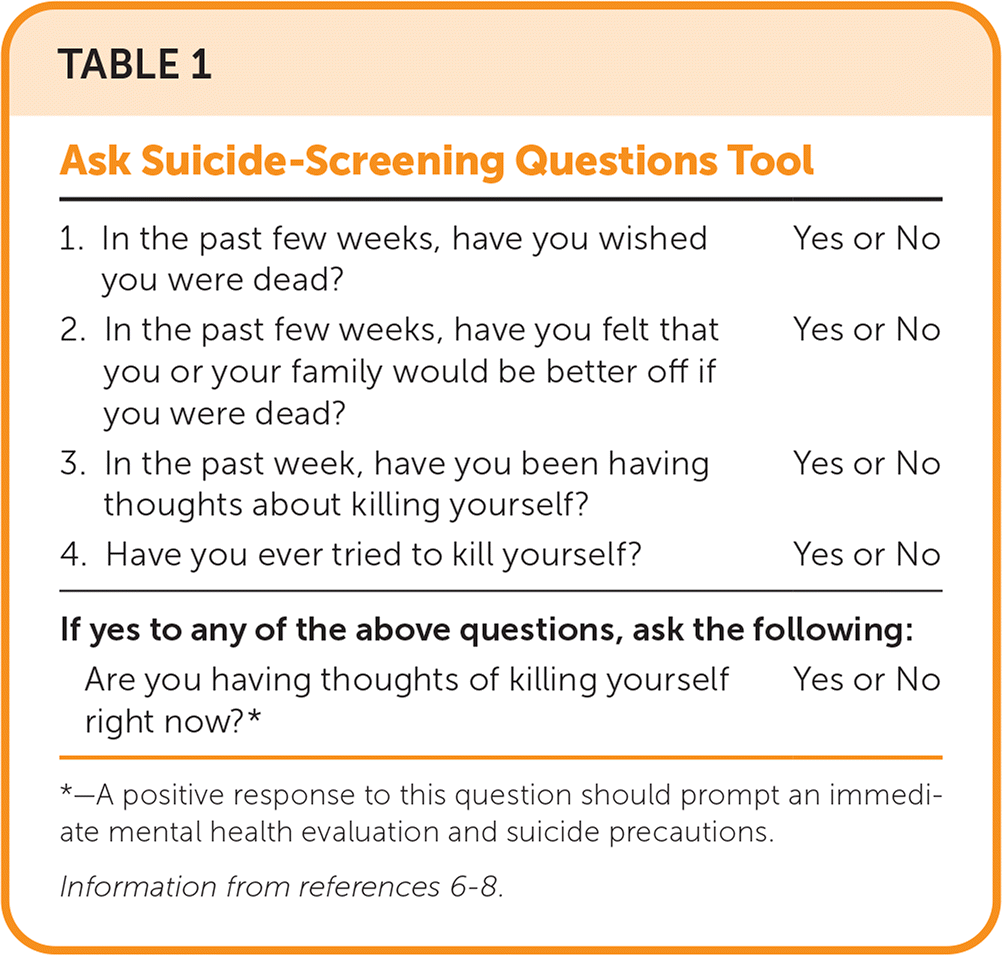
Am Fam Physician. 2023;108(3):311-312
Author disclosure: No relevant financial relationships.
Clinical Question
In a health care setting, is it possible to identify adolescents and adults who are at risk for suicidal ideation or behavior?
Evidence Summary
Rates of suicide have been increasing in the United States the past decade, especially among Black and Hispanic youths.1 Encounters with the health system are common before suicide, and simple screening tools may help primary care and emergency physicians identify adolescents and adults at increased risk for suicide who need further evaluation.2
The Columbia-Suicide Severity Rating Scale was developed and validated for use by members of the public and clinicians to help identify people at increased risk for suicide.3 It has been well validated in community and emergency department settings but has not been evaluated in the primary care setting. It comprises two initial questions and three to four follow-up questions and is available at https://cssrs.columbia.edu/wp-content/uploads/Columbia_Protocol.pdf.
A three-item risk score was developed in a population of 6,933 patients, 11 years and older, presenting to an emergency department in England with self-harm or attempted suicide, with a goal of predicting repeated self-harm in the next six months.4 The items included questions about current or previous psychiatric treatment, history of self-harm, and whether benzodiazepines were used in the current attempt. It was validated in an additional 2,153 patients. The patients who answered no to all three items had a 2.6% risk of repeated self-harm, whereas those with one or more positive responses had a 22% risk.
The Ask Suicide-Screening Questions (ASQ) tool was initially developed in 521 patients in the emergency department, 10 to 21 years of age, using elevated risk in the proprietary 15-item Suicide Ideation Questionnaire (SIQ) as the reference standard.5 Based on a multivariate analysis, the authors identified four questions independently associated with an increased risk for suicide (Table 16–8).

| 1. In the past few weeks, have you wished you were dead? | Yes or No |
| 2. In the past few weeks, have you felt that you or your family would be better off if you were dead? | Yes or No |
| 3. In the past week, have you been having thoughts about killing yourself? | Yes or No |
| 4. Have you ever tried to kill yourself? | Yes or No |
| If yes to any of the above questions, ask the following: | |
| Are you having thoughts of killing yourself right now?* | Yes or No |
The ASQ tool was prospectively validated in 2,740 adolescents, 12 to 17 years of age, presenting to a network of 14 U.S. pediatric emergency departments and one Indian Health Service site.6 This study is notable because participants were followed prospectively, and the primary outcome was a suicide attempt in the next three months. The score had excellent sensitivity (95.1%) and moderate specificity (58.8%); positive and negative likelihood ratios were 2.3 and 0.08, respectively. In the study population, 12.7% of patients with a positive screen attempted suicide in the next three months compared with only 0.5% with a negative screen, with an overall prevalence of 5.9% for a suicide attempt.
The ASQ tool was also validated in 515 outpatients, 10 to 21 years of age, including 180 patients in primary care clinics, and it was compared with the SIQ. In this group, 24 patients had a positive SIQ. The tool was 100% sensitive and 91.2% specific, and it had a positive predictive value of 36% and a negative predictive value of 100%.7
The ASQ tool was prospectively validated in a population of 727 hospitalized adult medical and surgical patients using the Adult SIQ as the reference standard. In this population, 4.8% were classified by the reference standard as being at risk for suicide, and the ASQ was 100% sensitive and 89% specific. However, this population is not typical of primary care outpatients.8
The ASQ is an appropriate screening tool for people of all ages but has been best validated in patients 10 to 21 years of age. The National Institute of Mental Health has a website that offers toolkits for different settings and ages. It is available at https://www.nimh.nih.gov/research/research-conducted-at-nimh/asq-toolkit-materials.
Applying the Evidence
A 14-year-old male is brought by his parents to your primary care clinic for evaluation of contusions after an altercation at school, where he reports being bullied. You administer the ASQ tool, and he answers in the affirmative to the first and third items and the follow-up question. You arrange for an immediate mental health evaluation and initiate suicide precautions.
